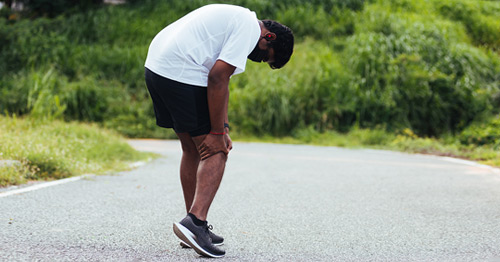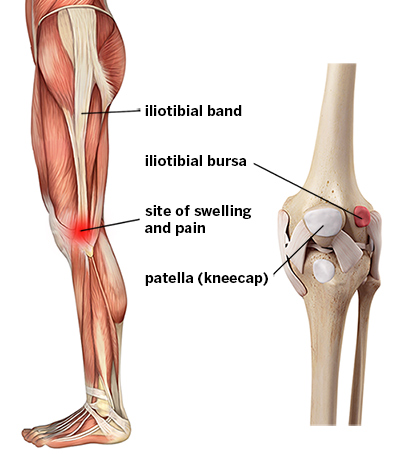Iliotibial Band (IT Band) Syndrome

If you are experiencing pain on the outside of your knee, you may have IT band syndrome or iliotibial band syndrome, sometimes referred to as "tight IT bands." This is a common condition in competitive athletes and other active people.
What is the IT band?
The iliotibial band or IT band is a long, fibrous band of flexible fascia that extends from the hip to just below the outside of the knee. It also has an attachment to the outside of your knee cap.
What is IT band syndrome?
IT band syndrome is a common overuse injury, causing pain at the outside of the knee. It is typically seen in runners and cyclists. Competitive rowers, skiers, and athletes playing soccer, basketball, and field hockey may also experience IT band syndrome.

What are the symptoms of IT band syndrome?
The most common symptom of IT band syndrome is knee pain – located on the outside of the knee – which increases as a person runs, cycles or performs other exercises that involve repetitive bending and straightening of the knee. One may also experience a feeling of clicking, popping or snapping on the outside of the knee.
(Find a doctor at HSS who can diagnose and treat IT band syndrome.)
What causes IT band syndrome?
The cause of IT band syndrome is controversial. It is commonly thought to be caused by the friction of repeatedly bending and straightening the knee that leads to inflammation of the area under the IT band. Other studies suggest it is actually the result of compressive forces to a fat pad that is deep to the IT band. Another theory suggests chronic inflammation of the IT band bursa.
There are various individual factors and training practices that may place excessive stress on the IT band and put athletes at risk:
Individual factors
- Anatomy: Variations in anatomy (such as hip and knee alignment) and excessive foot pronation can increase strain to the IT band.
- Flexibility: Decreased flexibility in different muscle groups can affect the way the foot, ankle, knee and hip joints move, causing compensations.
- Muscle strength: Muscle strength imbalances in the pelvis, hip, knees, foot and ankle can lead to faulty movement patterns and increase strain to the IT band.
- Muscle control: Decreased muscle coordination and control of the leg can lead to decreased alignment and lead to increased tension and stress at the knee.
Training factors
- Training surface: Training on tilted surfaces (such as always running in the same direction on the track) or repeated downhill running can lead to repetitive stress on the IT band.
- Training dosage: Sudden increase in training volume or intensity can lead to increased stress on the body, as well as faulty movement patterns.
- Shoe wear: The recommended shoe wear for runners ranges from 300 to 500 miles. Training in shoes that are too worn can alter the mechanics in the foot, ankle, knees, hip and pelvis.
How is IT band syndrome diagnosed?
If you think you may have IT band syndrome, you should consult a sports medicine physician, physiatrist or physical therapist. The doctor will interview you about your medical history and symptoms and conduct an exam to determine whether you have IT band syndrome or a different condition that may have similar symptoms, such as runner's knee, meniscus injuries, or stress fracture. If IT band syndrome is suspected, a physical therapist can work with you to identify your individual risk factors and start a treatment and prevention strategy.
(Find a doctor at HSS who can diagnose and treat IT band syndrome.)
What is the treatment for IT band syndrome?
The key treatment for IT band syndrome is to rest from the activity that is causing the pain. This should be followed up with a consultation with a physical therapist who can help determine the causes of your IT band syndrome and provide exercises and cross-training tips in addition to reviewing your risk factors. Addressing improper running form and poor bike fit are additional interventions that are important in a comprehensive treatment plan. After a physical therapy program is completed, competitive athletes should consider working with a fitness professional or athletic trainer to design training workouts that will help prevent recurrence.
How do you prevent IT band syndrome?
Prevention of IT band syndrome is geared toward correcting any individual risk factors or training errors that contributed to the injury. A comprehensive exercise program includes flexibility, strength training and gaining correct control at the pelvis, hips, knees, foot and ankle. Be sure to consult a health and fitness professional before participating in a new training or rehabilitation program.
Iliotibial Band (IT Band) Syndrome Success Stories
In the news
Updated: 6/21/2022
Reviewed and updated by Yukiko Matsuzaki PT, DPT, OCS, SCS, with contributions by Curtis Wu PT, DPT, OCS, SCS, CSCS.
References
- Hadeed A, Tapscott DC. Iliotibial Band Friction Syndrome. StatPearls. StatPearls Publishing; 2022.
- Geisler PR. Current clinical concepts: synthesizing the available evidence for improved clinical outcomes in iliotibial band impingement syndrome. J Athl Train. 2021; 56(8):805-815.
- Strauss EJ, Kim S, Calcei JG, Park D. Iliotibial band syndrome: evaluation and management. J Am Acad Orthop Surg. 2011; 19(12):728-36.

